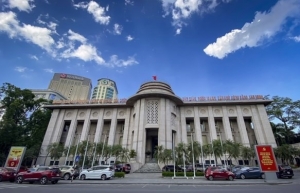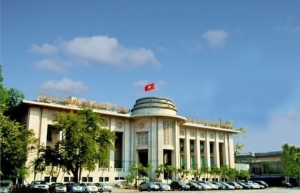Staying ahead with fiscal and monetary milestones
How do you see the recent move by the State Bank of Vietnam (SBV) to raise interest rates?
 |
| Economist Le Xuan Nghia |
The State Bank of Vietnam has increased interest rates to achieve two goals. The first is to reduce the money supply by lowering the borrowing demand of both enterprises and individuals. An increase in interest rates by the SVB triggers rises in interest rates at commercial banks. Without action, this policy will have no meaning. Before borrowing money from commercial banks, individuals and businesses have to take into consideration the amount, time, and purpose of the loan in light of the SBV’s signals.
The second is to increase the value of the VND against other currencies, especially the US dollar. The move is in response to the wave of interest rate hikes and monetary tightening implemented by central banks worldwide.
Ultimately, both goals aim to alleviate inflationary pressure, particularly from imports through the exchange rate and an increase in global market prices, such as fuel.
However, Vietnamese businesses are facing major challenges, including rising input prices and decreasing output prices, especially for exports, due to weak demand in Vietnam’s key trading partners like the United States and China. As the corporate bond market stagnates, capital appropriation in enterprises becomes more common.
The majority of businesses, on the other hand, began investing in business and production at the beginning of 2022 and have continued to do so. As a result, there is a high demand for fixed and working capital. However, the SBV must tighten monetary policy to reduce inflation and stabilise the macroeconomic environment.
The SBV has taken several measures to manage the money supply and stabilise the exchange rate since the beginning of the year. However, the market is still under extreme stress. Overnight lending rates sometimes reach 5 per cent, even 9 per cent recently. For a period of six months, the interbank interest rate was around 8 per cent. The state management agencies have tried to sell the SBV’s bills of exchange, activate open market operations, and sell sizable sums of foreign currency reserves to stabilise the money market. However, monetary policy is still under external pressure.
Firstly, the US and other central banks will continue to raise interest rates due to high inflation, which shows no signs of abating. Secondly, the economies of many nations, particularly the US and the United Kingdom, show signs of a mild recession. It is also challenging for the European economy to buck the trend.
This may lead to Vietnam’s slowing export growth and economic deterioration in the upcoming months, particularly in 2023. It also increases the trade and current account deficits, which pressure the exchange rate significantly. As a result, it is imperative that the SBV raises interest rates while keeping credit room tight.
Borrowers are complaining about high interest rates making production and business difficult. What are your suggestions to address this?
As businesses are in dire need of capital, the banking system can reduce operating costs and increase profits in the service and financial sectors to limit the increase of lending interest rates to a reasonable level. In particular, large commercial banks with a high proportion of saving deposits have better conditions to limit the increase in rates.
However, this is not an easy thing to achieve when many banks have large bad debts. Many businesses struggled to recover post-pandemic while the stock, real estate, and bond markets declined. This means some commercial banks have difficulty with liquidity, as evidenced by increasing interbank rates. The most pressing issue right now for the banking system and the SBV is to protect and stabilise liquidity while maintaining credit at a reasonable level rather than expanding it.
The interest rate is fairly high following the recent hike and is likely to rise further. What is your view on this projection?
The SBV has increased the operating interest rate by 1 per cent. I was quite surprised at this strong move. In my opinion, it is necessary to recognise that the SBV’s refinancing and rediscount rates do not have much impact on the monetary market. The increase in the deposit rate ceiling is a really meaningful move for the credit market.
The interest rates in the interbank market and the deposit and lending rates in many commercial banks have increased by about 0.5 per cent. Therefore, the recent interest rate hike partially justifies the trend of interest rate hikes that have existed in markets for many months.
Many are concerned that there is no more room left for monetary and fiscal policy. What is your insight on this?
Vietnam has strong economic growth with relatively low inflation. The VND has depreciated less against the US dollar than most other currencies. So, it cannot be said that Vietnam has much run out of room for fiscal and monetary policies thus far.
More specifically, for monetary policy, Vietnam has a relatively low obligatory reserve for credit institutions, which have an interest rate of 3 per cent for no-term and deposits of less than 12 months, and an interest rate of 1 per cent for deposits of more than 12 months.
Meanwhile, the figures for the US and China are above 10 per cent. Vietnam has a relatively low core inflation rate, below 4 per cent compared to the US and Europe at 6 per cent to 6.5 per cent, respectively. Vietnam has a solid amount of foreign currency reserves.
The country has imposed a high import tax and a special consumption tax, which benefits the budget. The government debt ratio of the nation is relatively low at 43 per cent. The ratio of debt repayment obligations to exports is also relatively low.
Meanwhile, the debt repayment obligation compared to the budget revenue is relatively high but below the permitted threshold.
Vietnam can continue to use the tools of fiscal and monetary policy in an efficient, flexible, and coordinated manner to stabilise the macro-economy and maintain reasonable growth.
In addition, Vietnam has a large volume of as-yet-disbursed public investment capital. If the government, ministries, branches, and localities can remove obstacles in site clearance and compensation procedures, a large amount of money can be released to the market. This investment capital has the fastest spillover effect, especially in construction, transportation, and real estate.
According to our forecast, Vietnam’s economic growth may reach 7.4 per cent in 2022, with average inflation of 3.9 per cent and on-year inflation of 5 per cent. VND may depreciate by as much as 5 per cent versus the US dollar.
Vietnam’s economic growth could reach 5.5 per cent in 2023, with average inflation surpassing 4 per cent. These are not poor economic indicators, given that the world economy is forecasted to register GDP growth of only 2.9 per cent with global inflation of about 6 per cent.
 | State Bank revises up interest rates by 1 percent from September 23 Governor of the State Bank of Vietnam Nguyen Thi Hong has issued decisions on revising up several interest rates by 1 percent, starting from September 23. |
 | Central bank acts to tighten dong liquidity The State Bank of Vietnam (SBV) has net withdrawn VND57.6 trillion through open market operation (OMO) and foreign currency selling channels to maintain the liquidity of the banking system at a sufficient level and create indirect impacts on the interbank interest rates. |
What the stars mean:
★ Poor ★ ★ Promising ★★★ Good ★★★★ Very good ★★★★★ Exceptional
Related Contents
Latest News
More News
- Gold market reform advances as SBV receives applications for bullion production (December 30, 2025 | 12:07)
- EVN and AFD sign credit agreement for Vietnam’s first pumped storage hydropower plant (December 30, 2025 | 10:06)
- Techcombank Priority Visa Signature unlocks a higher standard of living (December 29, 2025 | 16:44)
- Tax sector wraps up 2025 and sets priorities for next year (December 25, 2025 | 14:00)
- A tipping point for digital and hybrid wealth management in Vietnam (December 23, 2025 | 13:33)
- $250 million deal targets women-owned SMEs, sustainable agriculture (December 22, 2025 | 17:40)
- Stock market posts resilient 2025 performance (December 19, 2025 | 18:17)
- Citi Vietnam receives 2025 AmCham CSR recognition (December 19, 2025 | 16:35)
- As global green supply chain reshapes, will Vietnam be left behind? (December 19, 2025 | 08:00)
- Banks gear up for massive capital increases (December 18, 2025 | 17:04)

 Tag:
Tag:





















 Mobile Version
Mobile Version